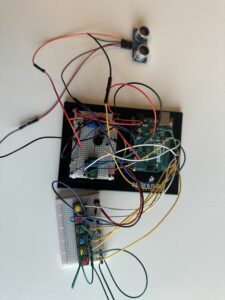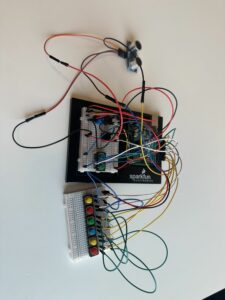Concept
The Digital Piano with Distance-Sensing Percussions is an innovative musical instrument that blends traditional piano elements with modern sensor technology to create a unique and interactive musical experience. This project utilizes an array of digital push buttons connected to an Arduino board to simulate a piano keyboard, where each button triggers a distinct musical note. In addition to the conventional keyboard setup, the instrument incorporates an ultrasonic distance sensor, which introduces a dynamic layer of percussion sounds. These sounds vary depending on the distance of the player’s hand. Furthermore, a potentiometer is integrated to alter the pitch of the notes dynamically, offering musicians the ability to manipulate the sound palette expressively.
Images
Components Used
- Arduino Uno
- Breadboard (x2)
- Jumper Wires
- Piezo Buzzer (x2)
- Push Buttons (x8)
- Potentiometer
- 10k ohm resistors (x8)
- Ultrasonic Sensor
Circuit Setup
Power Connections
-
-
- Arduino 5V to Breadboard positive rail
- Arduino GND to Breadboard negative rail
-
Piezo Buzzers
-
- Piezo Buzzer 1:
- Positive connection to Arduino digital pin 12
- Negative connection to Breadboard negative rail
- Piezo Buzzer 2:
- Positive connection to Arduino digital pin 13
- Negative connection to Breadboard negative rail
- Piezo Buzzer 1:
Push Buttons
-
-
- One side of each button connected to the Breadboard positive rail
- The other side of each button is connected through a 10k ohm resistor to the Breadboard negative rail and also connected to Arduino digital pins 2 through 9.
-
Potentiometer
-
-
- One outer pin is connected to the Breadboard positive rail.
- Another outer pin is connected to the Breadboard negative rail.
- Middle pin connected to Arduino analog pin A0.
-
Ultrasonic Sensor
-
-
- VCC pin is connected to the Breadboard positive rail.
- GND pin is connected to the Breadboard negative rail.
- TRIG pin is connected to Arduino digital pin 10.
- ECHO pin is connected to Arduino digital pin 11.
-
Video
Code
int buzzerPin = 12;
int buzzer2 = 13;
int potPin = A0;
int keys[] = {2, 3, 4, 5, 6, 7, 8, 9};
// Frequencies for notes (C4 to C5)
int notes[] = {262, 294, 330, 349, 392, 440, 494, 523};
int trigPin = 10;
int echoPin = 11;
int bassDrum = 200;
int snare = 250;
int hiHat = 300;
void setup() {
pinMode(buzzerPin, OUTPUT);
pinMode(buzzer2,OUTPUT);
pinMode(2,INPUT);
pinMode(3,INPUT);
pinMode(4,INPUT);
pinMode(5,INPUT);
pinMode(6,INPUT);
pinMode(7,INPUT);
pinMode(8,INPUT);
pinMode(9,INPUT);
pinMode(trigPin, OUTPUT);
pinMode(echoPin, INPUT);
Serial.begin(9600);
}
void loop() {
int potValue = analogRead(potPin);
int volume = map(potValue, 0, 1023, 0, 255); // Map the potentiometer value to a volume range
// Measure distance using the ultrasonic sensor
digitalWrite(trigPin, LOW);
delayMicroseconds(2);
digitalWrite(trigPin, HIGH);
delayMicroseconds(10);
digitalWrite(trigPin, LOW);
long duration = pulseIn(echoPin, HIGH);
int distance = duration * 0.034 / 2; // Calculate the distance
Serial.print(distance);
Serial.println(" cm");
bool isAnyButtonPressed = false;
for (int i = 0; i < 8; i++) {
int modifiedNote = map(potValue, 0, 1023, notes[i] / 2, notes[i] * 2);
if (digitalRead(keys[i]) == HIGH) {
tone(buzzerPin, modifiedNote, 100);
isAnyButtonPressed = true;
break; // Stop the loop once a button is found pressed
}
}
if (!isAnyButtonPressed) {
noTone(buzzerPin);
}
if (distance < 10) {
tone(buzzer2, bassDrum, 100);
} else if (distance >= 10 && distance < 20) {
tone(buzzer2, snare, 100);
} else if (distance >= 20 && distance < 30) {
tone(buzzer2, hiHat, 100);
} else {
noTone(buzzer2);
}
delay(100);
}
In the loop, the program first reads the potentiometer value and uses it to modify the frequency of the piano notes. Depending on the button pressed, it plays a modified note frequency. If no buttons are pressed, it stops any ongoing tone. Depending on the distance detected, it chooses a percussion sound to play, simulating a drum kit with different sounds for different ranges.


